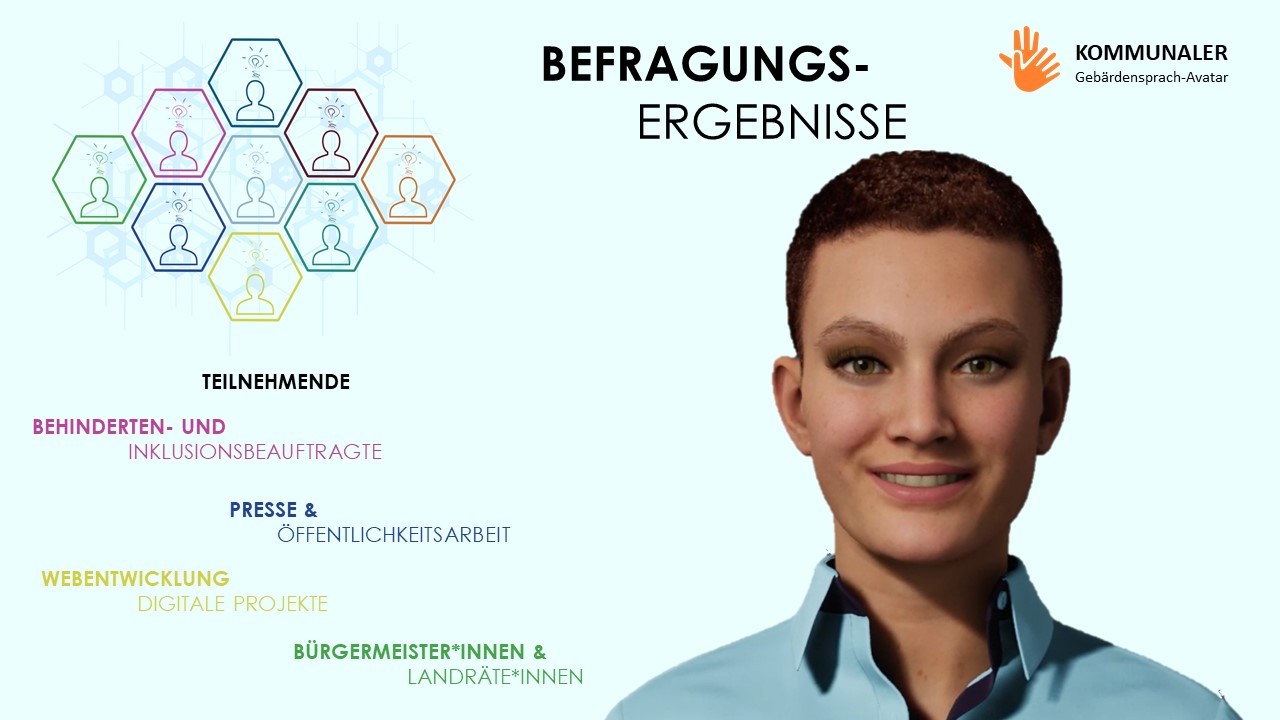
The project Municipal Sign Language Avatar (MSLA) aims to implement an AI-based platform for the automated translation of municipal texts into sign language. For this purpose, municipal content will be collected, processed and made available to municipalities and districts in a modularly composable form for individual translation using computer-generated sign language avatar animation.
Sign language videos can currently only be produced manually. Content that needs to be updated requires a new production. This is costly and involves high follow-up costs due to the manual production process. The vocabulary of the texts to be translated is also required in a similar form by other municipalities and districts. Municipal expenditures are made several times for the same topics.
With the Municipal Sign Language Avatar, a platform is to be made available to which municipalities and districts can access and generate content independently in sign language based on AI. The Municipal Sign Language Avatar thus enables more than the implementation of the minimum requirements of BITV 2.0 (Barrier-Free Information Technology Ordinance). Rather, it offers the possibility of keeping content up-to-date, reducing costs for multiple production through intelligent solutions, as well as reducing barriers and enabling "real" digital barrier-free communication.
As part of the preliminary work on the MSLA, municipalities and districts were asked about their requirements and wishes. The summary of the results is available for download here (in German) and all findings will be incorporated into the implementation of the Municipal Sign Language Avatar in close coordination with the municipalities and districts.
From many discussions with deaf experts, disability advisory boards of the districts and municipalities, we also know how critical the use of such a solution is seen and that there are many misunderstandings about the exact form of the use of a sign language avatar. The main criticism of the solutions available nationally or internationally to date is the lack of facial expressions, a limited body language and the representation by comic-like characters. In the implementation of the Communal Sign Language Avatar this criticism is taken into account. By working with deaf people, we implement this through a multi-level quality control process that allows for an optimal translation of text into sign language via the modular building block.
The survey results show that more than 90 % of the 366 surveyed advisory boards for the disabled, disability and inclusion officers, press and public relations contacts, web developers and digitization officers, as well as mayors and district councillors can very well imagine using the sign language avatar for deaf communication in digital applications .
It is important for us to address the discourse about the use of sign language avatars for more digital accessibility. In the survey, we received feedback from both hearing and deaf participants. Beyond the survey, we are aware that there is definitely, as mentioned above, criticism of solutions with sign language avatars currently available on the market nationally but especially internationally. We are in continuous exchange with deaf experts and the results of studies and surveys of deaf focus groups as well as the feedback from the community give us the direction for the development. Especially the criticism of missing facial expressions, insufficient gestures and body language, but also the demand of a human or photorealistic appearance we have faced and will be able to implement them directly in the "Municipal Sign Language Avatar". In this context, we recommend for a more comprehensive insight into the topic and its challenges the broadcast of the Bayerischer Rundfunk from the series "Sehen statt Hören" - Avatare & Co, Mehr digitale Teilhabe durch Künstliche Intelligenz? from June 19, 2021, and the Best Practice Study of the University of Vienna "Avatars for Sign Language: Best Practice Guide for Practice".
In the whole very complex production process for sign language animations as a basis for the content of the kit, deaf and hearing sign language interpreters are used and create together with experts from other fields of research and development a solution for an unprecedented digital participation.
Learn more about the application, presentation requirements and prioritization of relevant topics. The benefits in terms of compliance with legal requirements, cost savings, social responsibility, increased website traffic, and image-enhancing use of innovation are also evident. Download the summary of results here (in German).
We look forward to your feedback, to participate in the implementation and to work together with us on a more comprehensive digital accessibility. Feel free to contact us (view Mr. Ingmar Dorp's calendar and book a time here)!